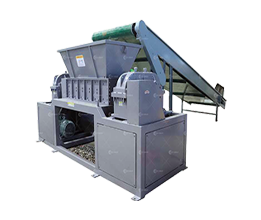Can a twin-shaft shredder be integrated into a recycling line?
In modern recycling facilities, efficiency isn’t a luxury—it’s a necessity. With waste streams becoming more complex and customer expectations rising, companies are constantly searching for equipment that boosts throughput, enhances stability, and reduces operating costs. Enter the twin-shaft shredder—a heavy-duty workhorse known for its torque, durability, and ability to process stubborn materials that single-shaft systems simply cannot handle.But the big question many recyclers ask is:Can a twin-shaft shredder be integrated into a recycling line?The short answer is YES,
The Powerful Role of a Twin-Shaft Shredder
A twin-shaft crusher (also called a dual-shaft shredder or double-shaft shredder) is engineered to tear through bulky, dense, or reinforced materials using two counter-rotating shafts with high-torque cutting blades. This design delivers:
- Consistent low-speed, high-torque processing
- Stable shredding of tough, tangled, or metal-contaminated waste
- Lower energy consumption compared to high-speed crushers
- Improved output uniformity for downstream sorting or granulation
Industries use these machines for plastics, scrap metal, wood, biomass, e-waste, MSW, textiles, rubber, and more.
Why Integration Works (And Why It’s Becoming Essential)
Integrating a twin-shaft shredder into a recycling line offers several game-changing advantages:
1. Enhanced Pre-Processing Efficiency
A twin-shaft shredder reduces the size of incoming waste, making it easier for conveyors, screens, magnetic separators, eddy current systems, or granulators to work without blockages.
2. Increased Throughput
According to industry statistics, adding a high-torque shredder can raise the total line capacity by 20–40%, especially in lines dealing with bulky or irregular waste streams.
3. Better Protection for Downstream Equipment
By breaking down large or rigid materials early, the shredder prevents jams, overloads, and blade damage in secondary shredders or grinders.
4. More Uniform Output
Consistent particle size improves sorting accuracy, washing performance, or melting consistency—depending on your recycling application.
5. Higher Material Recovery Rates
When waste is properly cracked open, internal components (such as metals inside appliances or plastic layers in composites) can be separated more effectively.
How Is a Twin-Shaft Shredder Integrated Into a Recycling Line?
Step 1: Identify the Input Material
Different materials require different blade configurations, speeds, and torque levels. Proper analysis ensures the shredder matches your target waste stream.
Step 2: Choose the Right Line Position
A twin-shaft shredder can be installed:
At the front – for bulky waste, pallets, sheets, large plastics, or appliances
Before secondary shredding – for materials requiring staged reduction
Before washing – for plastic films or rigid plastics
Before separation – for composite materials, e-waste, or metal-plastic mixtures
Step 3: Integrate With Conveying & Feeding Systems
To ensure a continuous workflow, the shredder typically connects with:
Hopper feeders
Belt conveyors
Screw conveyors
Hydraulic pushers
This prevents bridging or uneven loading.
Step 4: Add Sensors & Safety Controls
Modern integration includes:
Overload protection
Automatic torque adjustments
Anti-jam reversal systems
Line synchronization PLC controls
Step 5: Test Output Compatibility
Final output size should match the requirement of the next stage—often between 20–80 mm, depending on application.
Frequently Asked Questions (FAQ)
1. Is a twin-shaft shredder suitable for plastic recycling lines?
Absolutely. It is widely used for HDPE drums, PET bales, LDPE film rolls, pipes, crates, and automotive plastics—especially for bulky items that traditional shredders struggle with.
2. Can it handle metal-contaminated waste?
Yes. Its low-speed, high-torque design allows it to process materials containing nails, bolts, or embedded metal with minimal damage to the blades.
3. Does integration require a complete line redesign?
In most cases, no. Twin-shaft shredder s can be inserted into existing lines using customized hoppers and conveyor connections.
4. How much maintenance is required?
Maintenance is simple: routine lubrication, torque checks, and occasional blade replacement. Many models allow quick-change blade modules to minimize downtime.
5. How big should the shredder be for my line?
Capacity depends on your throughput goals. Smaller models start at 500–800 kg/h, while industrial units can exceed 10+ tons per hour.
Adding a twin-shaft shredder delivers stronger pre-processing, increases throughput, reduces downstream maintenance, and raises recovery rates—especially in challenging waste environments. Whether you handle plastics, scrap metal, biomass, MSW, or industrial waste, a twin-shaft shredder can transform the efficiency and profitability of your recycling operation.
If you want a more resilient, faster, and more profitable recycling line, this upgrade is hard to beat. And with customization options for blade configuration, feeding style, and output sizing, integration is easier than ever.
Contact Us
Address
Henan Communication Industrial Park, Economic Development Zone, Zhengzhou City, Henan Province, China

